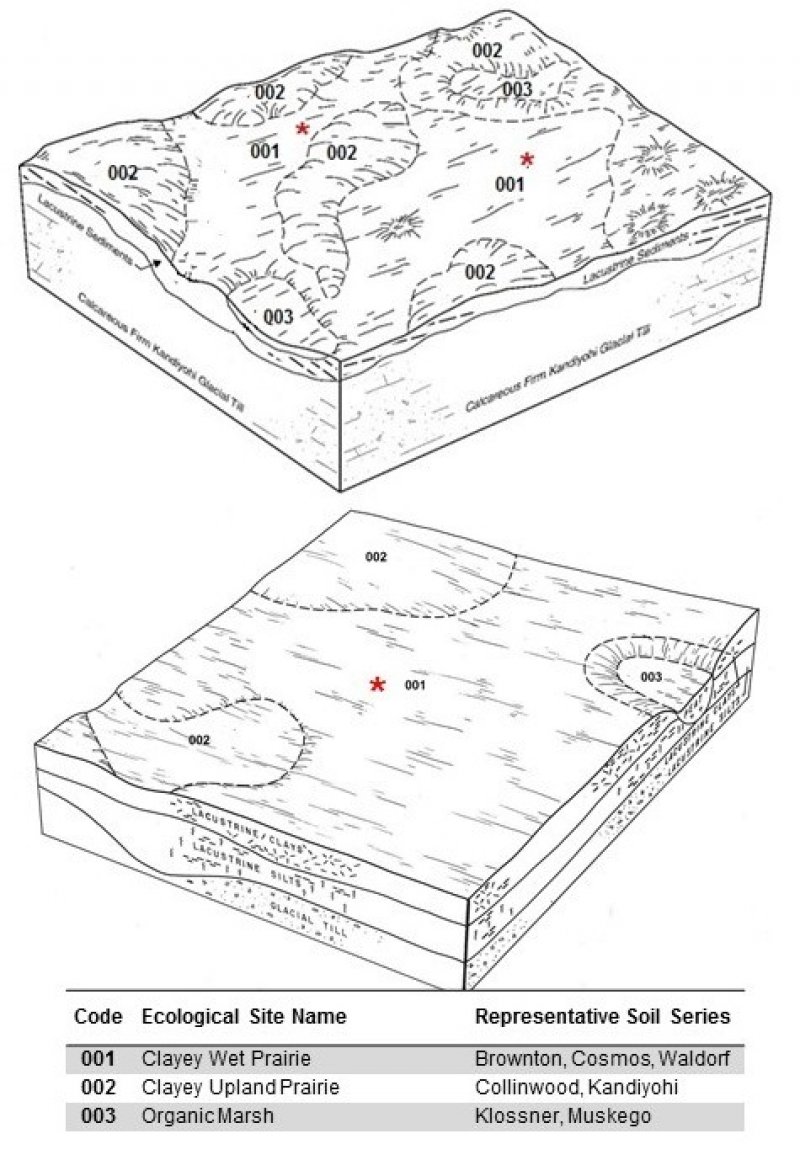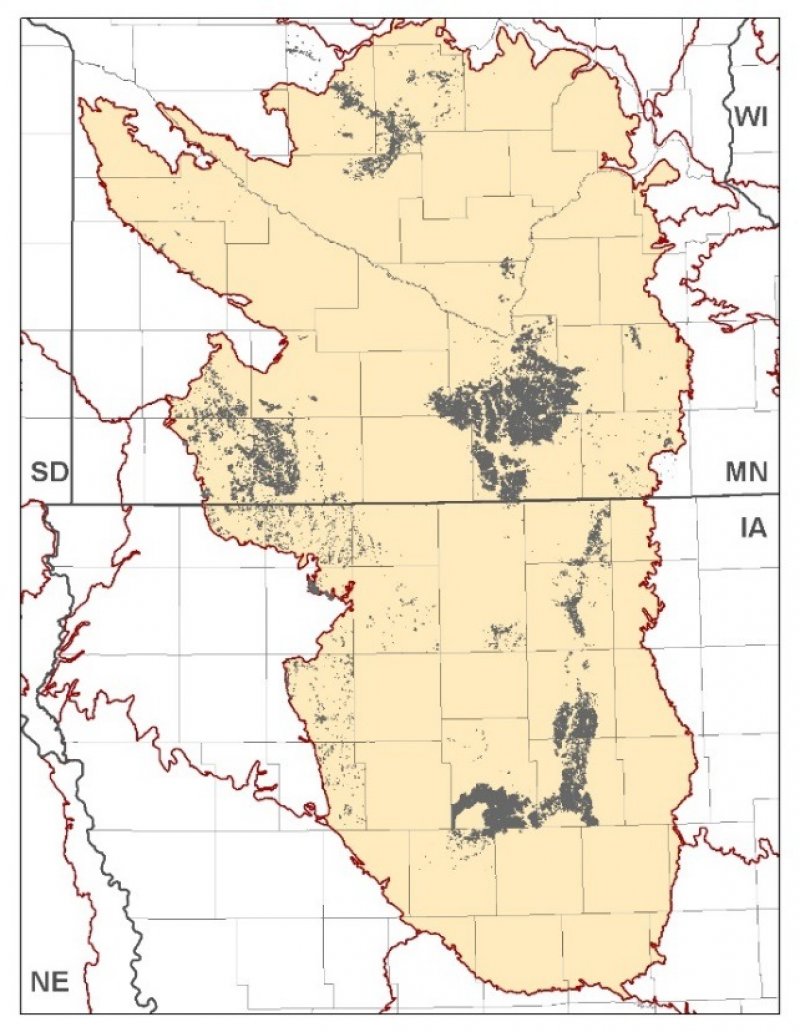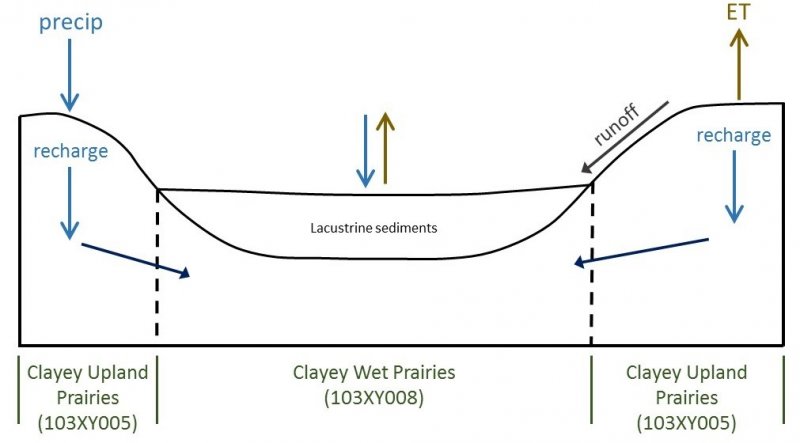Ecological dynamics
The Clayey Wet Prairies ecological site is characterized by three states: the Reference State, the Tillage State, and the Woodland State. The Reference State is a wet prairie with a diversity of native grasses, sedges, and forbs tolerant of poorly drained soils. The state has two plant communities that are characterized by different fire return intervals. The Tillage State describes sites that have been tilled and generally have modified hydrology (ditching, tiling). The Woodland State describes a disturbed community dominated by trees. Species on these sites will vary depending on the hydrology, disturbances, and seed sources.
Reference plant communities are characterized as wet prairie, which include a diversity of grasses, sedges, and forbs characteristic of poorly drained conditions. Prairie cordgrass (Spartina pectinata Bosc ex Link) is indicative of wetland conditions. Other grasses include big bluestem (Andropogon gerardii Vitman) and Indiangrass (Sorghastrum nutans (L.) Nash). Sedges are an important component, and several dozen species are possible. The most noteworthy species are Bicknell’s sedge (Carex bicknellii Britton), woolly sedge (Carex pellita Muhl ex. Willd.), and Buxbaum’s sedge (Carex buxbaumii Wahlenb.). Tussock-forming species like Hayden’s sedge (Carex haydenii Dewey) and upright sedge (Carex stricta Lam.) are also important. Common forbs include those typical of wetland conditions such as fourflower yellow loosestrife (Lysimachia quadriflora Sims) and swamp milkweed (Asclepias incarnata L.). Shrub cover is variable in density and includes willows (Salix L.) and dogwoods(Cornus L.), which quickly spread in the absence of frequent fire.
State 1
Reference State
The Clayey Wet Prairies reference state is a native prairie that has a diversity of wet-tolerant grasses and forbs. Community phases within the Reference State are dependent upon the influences of fire and grazing. Fire is a key trigger that promotes continued herbaceous vegetation dominance and removes dense thatch thereby allowing for seedling regeneration. Frequent fire maintains the community in a grassland state, by keeping fire-sensitive woody species from proliferating and gaining dominance. A secondary trigger is grazing. Intensive grazing reduces palatable species thereby allowing an increase in less desirable plants.
Today, high-quality, unplowed areas are extremely uncommon. Most remaining natural areas that are managed for tallgrass prairie were once tilled and utilized for agricultural production. It is therefore likely that many historically present species are extirpated even from these sites.
Resilience management. Prescribed fire and managed grazing are key resilience management practices. Managed grazing incorporates periods of grazing rest during the growing season which benefits tallgrass maintenance.
Community 1.1
High Diversity Prairie
This plant community consists of native wet-tolerant native grasses and forbs. The vegetative composition is influenced by fire return intervals of less than 3 years. Fire reduces woody species and maintains the natural diversity. Fire stimulates seed regeneration and reduces the amount of thatch.
Resilience management. Prescribed fire and managed grazing are key resilience management practices.
Community 1.2
Old Growth Prairie
This plant community is characterized by a fire return interval of 3 to 5 years, which is longer than that of Community 1.1. Grass species are still dominant, but more woody species are present.
Resilience management. Prescribed fire and grazing are resilience management practices. Although this community has a longer fire return interval than Community 1.1, it still relies on fire or grazing to maintain community structure.
Pathway 1.1A
Community 1.1 to 1.2
Fire is the primary trigger that affects the plant community composition. The frequency of fire is the primary factor affecting the transition from Community 1.1 and Community 1.2.
Pathway 1.1A consists of a fire free period of 3 to 5 years. It allows an increase in woody species, an increase in dead plant material, and a reduced rate of seedling regeneration. Encroachment by woody species will continue in the absence of fire. Although fire frequency is the main driver of community change, secondary triggers include grazing and drought.
Pathway 1.2A
Community 1.2 to 1.1
This pathway consists of a fire return interval of less than 3 years. Fire intolerant woody species are set back and thatch is reduced.
State 2
Tillage State
Tillage is the primary mechanism affecting the transition to this state. In this state, dynamic soil properties such as bulk density, structure, organic carbon content, and saturated hydraulic conductivity are altered by agricultural practices. Hydrological modifications (tiling and ditching) are commonly installed to improve drainage. Most areas in this state will remain in use for crop production in the foreseeable future – primarily in an intensive corn and soybean rotation.
Certain practices can mitigate the impacts of traditional agricultural practices on soil health. Conservation tillage minimizes soil disturbance and can improve soil structure and overall soil health. Corn or soybean plantings and a cover crop rotation can build soil structure, improve infiltration rates, reduce runoff, and protect water quality.
A small percentage of sites have been seeded back to warm-season grasses. Some previously tilled areas have been converted as part of the NRCS conservation program. Cool-season grasses are also feasible. Although seeded grasslands are not as biologically diverse as the reference state, they still offer various soil health benefits and some ecological benefits for grassland bird species.
Some tilled sites may revert to a woodland through abandonment; however, this is a small percentage of acres within MLRA 103 so is not currently given a community in this model.
Resilience management. Disturbance management and harvest management are resilience management practices. The maintenance of this state requires that the intensity, frequency, duration, and timing of agricultural practices (disturbances) be managed to control or modify vegetation structure.
Community 2.1
Row Crop Community
This community consists of intensively produced row crops. Tillage and intentional plant establishment (crop seeding) are the primary triggers. A secondary trigger is hydrological modifications (ditching and tiling) installed to improve soil drainage. Common crops are corn and soybeans on an annual rotation.
Resilience management. Disturbance management and harvest management are resilience management practices. The maintenance of the desired vegetation community requires management of the intensity, frequency, duration, and timing of disturbances caused by agricultural practices.
Community 2.2
Seeded Grassland Community
This community is on areas that were previously tilled and used for agricultural production but have been transitioned to either warm-season or cool-season grasses. Warm-season grasses are commonly planted through NRCS conservation programs. Species selection depends on landowner objectives and site-specific characteristics. Cool-season grass species are also feasible. Common species include reed canarygrass and Kentucky bluegrass.
Resilience management. Disturbance management and harvest management are resilience management practices on pastures. Practices include seeding and controlling weeds and brush.
Prescribed fire is a resilience management practice on warm-season grasslands. The controlled application of fire modifies vegetation structure and influence ecological processes.
Pathway 2.1.A
Community 2.1 to 2.2
This pathway converts Community 2.1 (row crops) to Community 2.2 (seeded grassland).
The primary mechanism of change is the seeding of desired grass species. .
| Forage and Biomass Planting |
|
Pathway 2.2.A
Community 2.2 to 2.1
This pathway converts seeded grassland to cropland. This is a common pathway throughout MLRA 103 as areas are placed in crop production.
State 3
Woodland State
In the absence of a natural fire regime or management, this site will transition towards a wooded community. Unmanaged grazing and invasive species may impact this site. Community composition and characteristics will vary depending on the type and severity of disturbances. Dominant tree species will vary but often include eastern cottonwood, black willow, green ash, and boxelder. Reed canarygrass may be dense on sites with open areas. Cool-season grasses are often present.
Few acres within MLRA 103 are in this State. Some remaining areas are conservation easements. Areas not in a conservation programs are likely to be jurisdictional wetlands, making it very unlikely they will be transitioned to State 2 due to various wetland programs and laws, including the Swampbuster provision of the Food Security Act of 1985 (P.L. 99-198, as amended by P.L. 115-25) and the Minnesota Wetland Conservation Act (WCA) of 1991 (M.R. 8420.0100, as amended in 2009).
Community 3.1
Woodland Community
This site is a woodland plant community usually consisting of various species of trees, shrubs, and often, non-native species. Common trees include eastern cottonwood, willows, green ash, boxelder, and dogwood. Open areas may be dominated by reed canarygrass and other cool-season, non-native grasses. Non-native herbaceous species are often present. Plant community composition will be determined by past disturbances, seed sources, any management inputs, and current disturbances.
Transition T1A
State 1 to 2
Transition T1A is the conversion of the reference state to agriculture. The triggers are tillage and intentional plant establishment (crop seeding). Hydrological modifications, such as ditching and tiling, are often also installed. Resilience management practices include continual agricultural practices such as seeding, fertilizing, and managing invasive plants with herbicides or field cultivation.
Constraints to recovery. Tillage and long-term intensive agricultural production generally preclude a return to State 1. Areas in row crop production may be placed in conservation programs and seeded with warm-season grasses, but will not exhibit the natural species diversity or ecological resiliency of State 1.
Some tilled areas may be abandoned and return to woodland, but this is a small percentage of acres and not currently given a community in this model. Most acres converted to agriculture will stay as such for the foreseeable future.
| Conservation Cover |
|
| Range Planting |
|
Transition T1B
State 1 to 3
Plant community succession via the lack of fire, grazing, or management. Woody species will increase and community structure will begin to move from a prairie to a woodland. Disturbances such as overgrazing and non-native vegetation may influence community composition and structure.
Restoration pathway R3A
State 3 to 1
Sites that have not been tilled and still have natural hydrologic functions may be feasible to restore. Soil structure is intact and remnant plant communities may still exist.
Previously tilled sites (State 2) may revert to a woodland through abandonment; however, the soil function has been altered through tillage and intensive crop production. This site will not be the same ecologically as a true reference site.



